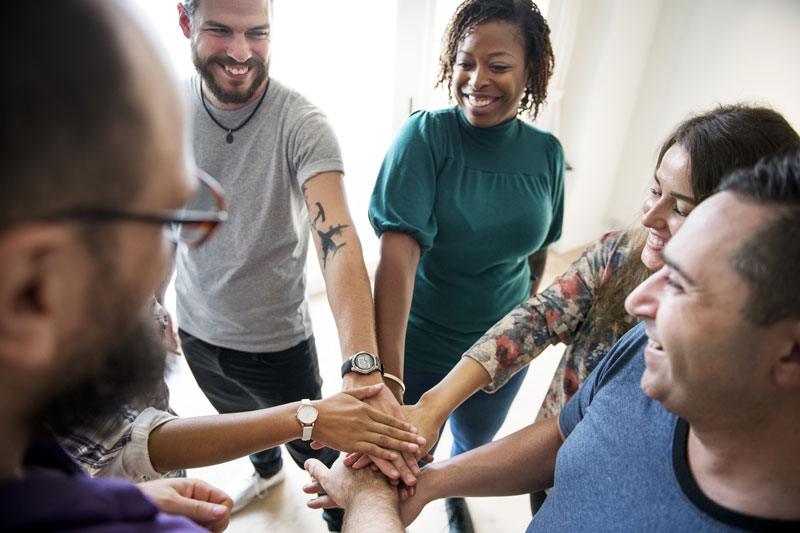Unity and Community: Strengthen Your Volunteer Corps
Posted Monday, October 28th, 2019 by Sterling Volunteers Staff

Have you ever wondered why some volunteers leave while others stay? There are lots of factors that impact a volunteer’s decision. Here we’ll look at some strategies to strengthen your volunteer corps and improve retention.
In a recent webinar, which is now available on-demand, nonprofit expert Beth Steinhorn, President of VQ Volunteer Strategies, shared her insights into how nonprofit organizations can improve leadership culture, retention, and more. She started off by contrasting two case studies that took place within the same building to highlight the issue at hand.
Two True Stories from the Same Building
1.
In her first story, Beth shared that a parent responded to a request to sell grocery cards to raise funds for her child’s school. The message she received implied that it would be easy – show up 15 minutes before, meet other parents, raise needed funds and go home … so she signed up and arrived as instructed.
Unfortunately, the building wasn’t open yet and when people finally showed up, they didn’t know where the necessary supplies were. By the time the responsible party arrived nothing had been set up and it was too late to do much of anything. The parent left, disappointed, after receiving a farewell similar to “Hey, lucky for you! You’re off the hook for today!”
She was looking for an opportunity to connect with other parents and staff and raise funds for the school. In the end she didn’t feel like she made any difference and therefore didn’t volunteer again.
2.
Beth shared that the same school partnered with 9Health Fair, an organization who provides free and low-cost health screenings and education throughout the state of Colorado. They partner with organizations that engage volunteers to help put on health fairs. Volunteers come from the community, and many of the medical volunteers are ongoing volunteers that show up at multiple 9Health Fair events.
Beth shared findings from a recent UJA Federation study that shows “whether or not an event volunteer returns is determined to a great extent by how organized that individual felt his or her experience was, because when volunteers have a good experience, they stay.”
The site director for 9Health stated “I will volunteer for you anywhere,” in part because she developed a personal relationship with volunteers and also enjoys sharing the positive results of their work.
Unity and Community
“When I say unity, I don’t mean homogeneity. Diversity can be a great thing. I’m talking about creating a unified vision, mission, and purpose for your volunteer corps, [as well as] a feeling of community.”
– Beth Steinhorn
Strategies for Building Unity and Community

Structure is Key
Give your volunteers the opportunity to interact with each other through the way you structure your program. You can help one-time volunteers succeed by encouraging them to interact with long-term volunteers in structured groups.
Creating Long-Term Groups
Placing your volunteers in long-term groups or “crews” is a great way to foster relationships and learning among volunteers. It also builds trust by offering autonomy to small groups, empowering them to help see your mission through, and encourages volunteers to stay with your organization. Beth suggests employing experienced volunteer supervisors to help spread culture and manage crews.
Community Building and Teamwork Tips
- Share your mission and show the effect of your work.
- Use workshops to help build and educate your community.
- Communicate each volunteer’s role clearly and provide clear instructions.
- Create interdependent roles that encourage collaboration and strengthen bonds.
- Provide instructions but encourage group problem-solving when it’s appropriate.
Train Your Volunteer Leaders
Engage volunteer team leaders through training that helps them make connections and promotes your organization’s mission. Offer them opportunities to continue their commitment and always listen to feedback. Provide more training and offer networking opportunities – both with their peers and with staff.

Consider the difference between leading and managing. It’s important to emphasize leadership in training and not just “how to get the job done.” A team leader’s responsibilities include improving retention rates. Help your leaders fulfill these responsibilities by clarifying their role through training.
Training Tips
- Connect with volunteers and thank them before and after events.
- Establish rapport.
- Create a welcoming atmosphere and team environment.
- Ask for feedback and advice.
Facilitate Social Media Sharing: Volunteer to Volunteer Content
Empower volunteers to promote your events, activities, and connect with others by telling their own stories, volunteer to volunteer. Encourage them to share opportunities and help recruit new volunteers by staying active on social media and asking your followers to share your message. Note that it’s important to be clear about your policies regarding what can and can’t be shared in regard to identity, messaging, etc., and moderate the platform you create.
Social Media Tips
- Develop and communicate a clear social media policy.
- Focus on the platforms where volunteers already spend time.
- Engage a volunteer leader to serve as your page admin.
- Allow for volunteers to post and share stories.
- Post content that volunteers can easily reshare.
Staff-Volunteer Celebrations
Create opportunities for your staff and volunteers to celebrate your mission together. Encourage attendance and consider how you set expectations. Conduct surveys about recognition and appreciation and use celebrations as a tool to address staff resistance to changes. You should also provide team-building opportunities and avenues for mutual appreciation for volunteers throughout the organization. But most importantly – always remember your mission and communicate it to your volunteers frequently.
Celebration Tips
- Keep your celebrations simple and unintimidating.
- Use name tags for large groups.
- Provide structured activities that promote social interaction.
Social Events
Go beyond staff-volunteer networking events and incorporate learning and structure into your events. The opportunity to learn and gain new skills and/or be recognized is a major motivator for volunteers.
Event Tips
- Feature your engaged volunteer leaders.
- Promote community and thank volunteers.
- Include a structured activity.
- Make it optional and gather feedback.
Watch the Webinar On-Demand
To learn more about how you can strengthen your volunteer corps, watch the “Beyond Potlucks! Building Unity and Community Within Your Volunteer Corps” webinar.
Connect with us on Facebook, Twitter, Linkedin.
The information contained herein is for informational purposes only. Sterling is not a law firm, and none of the information contained in this notice is intended as legal advice.
